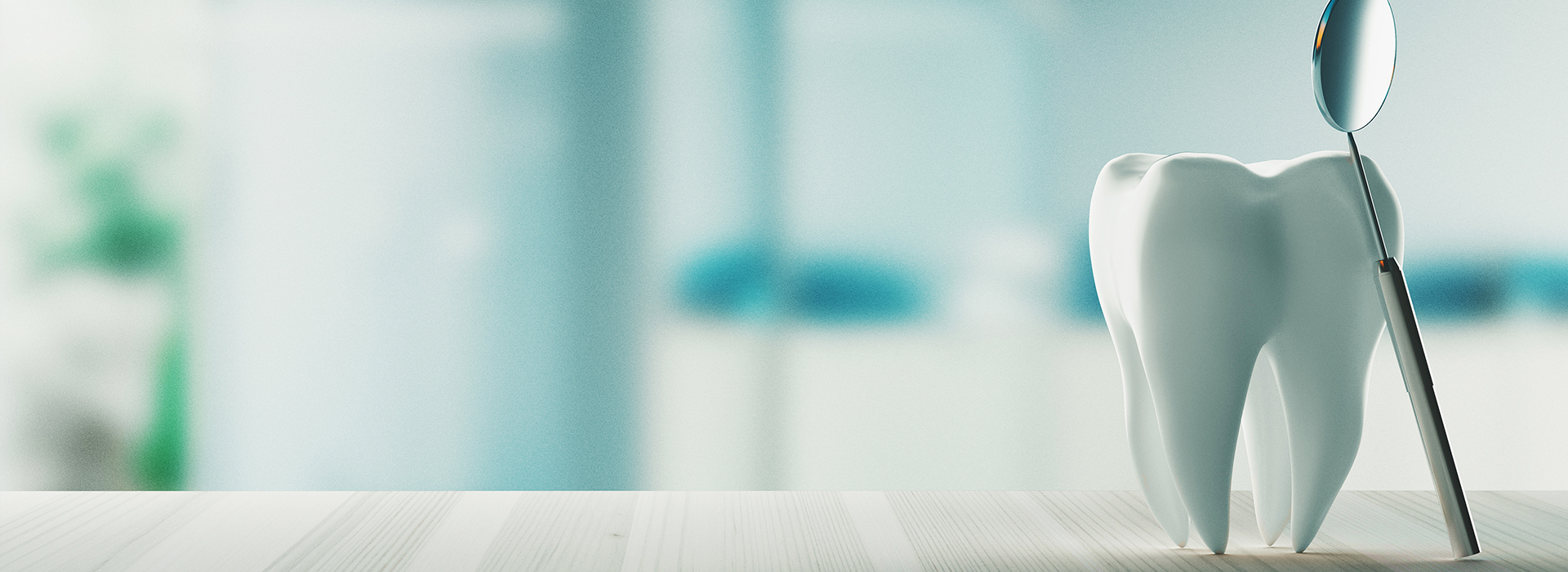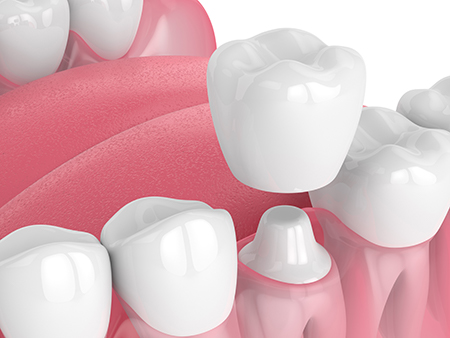
At Smiles Dental at Reston Town Center, we focus on delivering restorative care that balances durability with a natural appearance. Our team stays current with dental materials and digital workflows so patients receive reliable results that look like a real tooth and function comfortably for years to come.
Teeth are remarkably strong, but decay, injury, and wear can erode their structure until a simple filling is no longer sufficient. When a tooth has lost significant tooth structure or needs protection after root canal therapy, a full-coverage restoration is often the most predictable way to restore strength, bite, and appearance.
Advances in ceramic materials mean crowns can now be fabricated without any metal support, offering excellent longevity while more closely matching the translucency and sheen of natural enamel. These all-ceramic crowns combine aesthetic appeal with modern strength characteristics to meet both cosmetic and functional needs.
Every treatment plan is tailored to the person sitting in the chair. We take time to evaluate your oral health, discuss how a crown will affect your smile and bite, and explain alternatives so you can make an informed decision that fits your goals.
A crown is a cap that encases the visible portion of a tooth and restores its shape, strength, and alignment with adjacent teeth. Dentists commonly recommend a crown when a tooth has experienced substantial decay, has fractured, or has a very large existing filling that compromises structural integrity.
Crowns are also the standard restoration for teeth that have undergone root canal treatment because those teeth tend to become more brittle and can fracture under normal chewing forces. Likewise, crowns serve as prosthetic tops for dental implants and as connectors that anchor traditional bridges.
In addition to structural reasons, crowns can address aesthetic concerns—such as correcting a misshapen or discolored tooth—and can be part of a plan to harmonize a smile. During your consultation, we’ll review the health of the tooth, surrounding gum tissue, and bite to determine whether a crown or a more conservative restoration is the best path forward.

Today’s all-ceramic crowns offer a combination of realism and biocompatibility that older metal-based restorations can’t match. Their layered translucency and light-reflective qualities recreate the optical characteristics of natural enamel, making them an excellent choice where appearance matters.
Beyond looks, ceramic restorations are gentle on surrounding soft tissues and avoid the dark metal margins that can sometimes show near the gumline with porcelain-fused-to-metal crowns. Because they are metal-free, ceramics are suitable for patients with metal sensitivities and reduce the risk of galvanic reactions in the mouth.
Manufacturing advances have also improved strength. Some ceramics are engineered to withstand molar forces, while others prioritize translucency for front-tooth aesthetics. With proper case selection and care, contemporary ceramic crowns provide a blend of long-term function and attractive results.
Choosing a ceramic material involves balancing strength, aesthetics, and the demands placed on the tooth. For a front tooth where light transmission and color matching are critical, a highly translucent material may be preferred. For a back tooth subjected to heavy chewing forces, a tougher, more fracture-resistant ceramic is often a better choice.
Popular options include lithium disilicate and pressable porcelains for their pleasing appearance, as well as monolithic zirconia and high-translucency zirconia for exceptional strength and reliability. Each material has distinct handling and finishing characteristics; we select the type that best aligns with your bite dynamics and visual expectations.
We use digital shade analysis and, when appropriate, CAD/CAM milling to achieve precise fits and lifelike results. This thoughtful approach minimizes unnecessary tooth reduction while ensuring the restoration blends with your smile and performs well under normal use.

The process typically begins with a comprehensive examination, including images or digital scans to evaluate the tooth and surrounding structures. If a crown is recommended, the tooth is prepared by removing decayed or weakened areas and shaping the remaining structure to receive the restoration.
Many practices now use digital impressions to capture highly accurate three-dimensional images of the prepared tooth and bite. These scans either guide a laboratory technician or feed a milling unit that fabricates the crown. You may receive a temporary restoration while the final crown is being made, and on the day of placement we check fit, contact points, and color before final cementation.
Following placement, minor adjustments may be necessary to refine your bite. We provide guidance on caring for your new crown—proper brushing and flossing, avoiding extreme forces or habits like opening packaging with teeth—and schedule follow-ups to make sure everything is comfortable and performing as intended.

Our team combines restorative experience with modern diagnostic tools to plan and place crowns that meet both functional and cosmetic goals. We evaluate the whole mouth—how teeth meet, gum health, and jaw movement—to design restorations that integrate smoothly with your existing bite and smile.
We prioritize minimally invasive preparation techniques and precision fit to preserve as much healthy tooth as possible. Whether employing laboratory-fabricated ceramics or CAD/CAM-milled restorations, we consistently choose materials and methods that align with each patient’s needs.
Communication is central to our care. We’ll explain treatment choices, expected outcomes, and home-care practices so you understand each step and can feel confident in the results.
In summary, ceramic crowns are a versatile option for restoring strength, function, and appearance to compromised teeth. If you’re considering a crown or want to learn how ceramic materials might benefit your smile, please contact us for more information.

While a dental filling is designed to replace a portion of a decayed or damaged tooth, a dental crown offers full coverage to restore the tooth’s entire outer surface. A well-fitting dental crown not only protects and strengthens the underlying tooth structure, but it also restores the tooth’s appearance and function.
The procedure for getting an all-ceramic crown is much like the procedure for getting any other type of crown. In all cases, the tooth needs to be prepared, an impression taken, and a permanent crown cemented into place. A single all-ceramic crown can typically be fabricated over the course of two visits. However, with CAD/CAM technology, a same-day crown can be fabricated from start to finish in a single visit. With the first approach, a temporary crown is typically worn until the second visit, when the permanent restoration is placed. As with every treatment plan, our office will explain your best options in care.
As the name implies, a temporary crown is only worn for a short time until the permanent crown is placed. A temporary crown is typically fabricated from durable tooth-colored dental acrylics. While designed to protect the underlying tooth between appointments, and until your new permanent crown gets placed, a temporary crown is also fabricated to look like a natural tooth and maintain the look of your smile.
While you should feel better having an attractive and functional tooth to restore your smile, your tooth may feel a little sensitive following treatment. This initial sensitivity will subside. We take great care to make sure your new restoration looks great, fits well, and your bite is perfect. However, we’re always happy to make any minor adjustments to ensure your comfort.
With some exceptions, teeth with root canal procedures are typically restored and protected from further damage with a full-coverage crown. Based on what’s best for your smile, our office will recommend the most appropriate restoration to maintain the health and longevity of your tooth following a root canal procedure.
A dental crown is a long-term restoration that, if properly cared for, can serve you well for many years to come. Once your new crown is placed, it requires the same brushing, flossing, and periodic checkups as your natural teeth. Avoid biting your fingernails and chewing on hard or sticky objects such as ice, pencils, or taffy, which can damage or loosen your crown. Remember, clenching and grinding your teeth puts excessive pressure on both natural teeth and dental restorations. Unless treated, this habit can compromise the longevity and integrity of your dental work, including crowns.
Although your new all-ceramic crown restores the tooth's strength, form, and function, you can still develop dental disease in the absence of proper care. To prevent gum disease and tooth decay, it’s essential to brush and floss as instructed and see our office for routine checkups, cleanings, and care.
How long a dental crown lasts depends on various factors, including your level of oral care, diet, and oral habits. While the standard answer is that dental crowns can last anywhere from 5 to 15 years, existing literature confirms that most dental crowns remain in place at 15 to 20 years.
At the office of Smiles Dental at Reston Town Center, we strive to provide the highest quality of care to address all your dental needs. Once we’ve had the opportunity to examine your smile, we can give you a clear picture of any dental issues that are present, along with a quote for how much treatment will be. The cost of dental crowns can vary a little, depending on the type of crown and its location. Our goals are to provide the highest quality of care and help patients begin treatment without additional financial stress or delay. We’re always happy to answer all your questions on dental insurance coverage, available financing, and payment plans.
Coverage for all-ceramic crowns depends on your dental insurance plan. Today, many dental plans provide some level of coverage for all-ceramic crowns. At the office of Smiles Dental at Reston Town Center, we work with patients to optimize their dental benefits and get the care they need to maintain healthy and beautiful smiles!
A ceramic crown is a full-coverage dental restoration that fits over the visible portion of a damaged or weakened tooth to restore shape, strength, and function. These restorations are made from advanced, metal-free ceramics that mimic the translucency and surface texture of natural enamel. Because they cover the entire tooth, crowns protect remaining tooth structure and help re-establish proper contacts with adjacent teeth.
All-ceramic crowns are chosen for their aesthetic qualities as well as biocompatibility, making them a common option for front teeth and many posterior applications. They can be fabricated in a dental laboratory or milled in-office using CAD/CAM technology, providing flexibility in treatment planning. Your dentist will explain how a crown fits into a broader restorative plan to address both appearance and function.
A crown is typically recommended when a tooth has lost a significant amount of structure due to decay, fracture, or a very large existing filling that compromises strength. Teeth that have undergone root canal therapy are also frequent candidates for crowns because they can become more brittle and are at higher risk of fracture under normal chewing forces. Using a crown in these situations helps restore chewing function and prevents further damage.
Crowns are also used to correct cosmetic concerns such as severe discoloration or misshapen teeth when more conservative options are insufficient. They serve as prosthetic tops for implants and as anchoring units for fixed bridges when adjacent teeth must be restored. Your dentist will evaluate tooth health, gum tissue, and bite dynamics to determine whether a crown or a more conservative restoration is the best option.
Several ceramic materials are commonly used for crowns, each balancing strength and aesthetics in different ways. Lithium disilicate and pressable ceramics are prized for their lifelike translucency and color-matching ability, making them well-suited to front teeth, while monolithic zirconia and high-translucency zirconia offer exceptional fracture resistance for posterior teeth. Advances in ceramic formulations allow clinicians to choose materials tailored to the position of the tooth and the patient’s aesthetic expectations.
The choice of material also affects how the crown is finished and polished, which in turn influences how it interacts with opposing teeth and soft tissues. In many cases the laboratory or in-office milling system will be guided by the dentist’s specifications to balance longevity and appearance. Case selection and material science are both important to achieving a predictable, long-lasting result.
Selecting the appropriate ceramic involves an assessment of several clinical factors, including the tooth’s location, the amount of remaining tooth structure, bite forces, and the visual demands of the smile. For an anterior tooth where light transmission and shade matching are critical, a highly translucent material may be favored; for a molar subject to heavy chewing forces, a more fracture-resistant ceramic is often chosen. The dentist also considers habits such as clenching or grinding, the condition of opposing teeth, and the health of the surrounding gum tissue.
Digital tools like intraoral scans and shade-matching devices, together with diagnostic wax-ups or mock-ups, help the dentist and patient visualize the outcome and select a material that meets both functional and aesthetic goals. Communication with the dental laboratory or the in-office milling workflow ensures the chosen ceramic is fabricated and finished appropriately for the individual case. This tailored approach reduces unnecessary tooth reduction while improving long-term performance.
Treatment typically begins with a comprehensive exam that may include digital X-rays and intraoral scans to evaluate the tooth and surrounding structures. The tooth is then prepared by removing decay or weakened areas and shaping the remaining tooth to receive the crown; at that time a digital or physical impression is taken and a temporary restoration may be placed to protect the tooth. If appropriate, the practice will use CAD/CAM milling or send impressions to a dental laboratory for final fabrication.
When the final crown is returned or milled, the dentist checks fit, contacts, and color, makes any minor adjustments, and permanently cements or attaches the restoration. After placement the bite is evaluated and refined as needed to ensure comfort and function, and follow-up visits are scheduled to monitor the restoration. At Smiles Dental at Reston Town Center we emphasize clear explanations at each step so patients understand the process and expected outcomes.
Ceramic crowns can provide long-term service and often last a decade or longer with proper care and favorable clinical conditions. Longevity depends on factors such as the type of ceramic chosen, the quality of the tooth preparation and fit, the patient’s bite and parafunctional habits, and the regularity of professional maintenance. A well-fitted crown on a tooth with healthy supporting structures and good oral hygiene is more likely to perform well for many years.
Conversely, crowns can fail earlier if they are placed on teeth with untreated gum disease, poorly controlled grinding, or inadequate opposing tooth support. The cementation technique and precision of the restoration also influence outcomes, as do timely repairs when small issues arise. Routine dental visits allow your dentist to identify wear, marginal breakdown, or other concerns early and address them before more extensive treatment is needed.
Caring for a ceramic crown is much like caring for a natural tooth and includes regular brushing with a fluoride toothpaste and daily flossing to keep the margin between the crown and gum tissue clean. Avoiding hard or abrasive habits—such as opening packages with teeth or chewing very hard objects—reduces the risk of chipping or fracture. If you grind or clench your teeth, a custom night guard can protect the crown and opposing dentition from excessive forces.
Regular dental checkups and professional cleanings are important so your dentist can assess the health of the crown, the integrity of the margin, and the condition of surrounding gums. Promptly report any sensitivity, looseness, or changes in bite so adjustments or repairs can be made before complications develop. Good home care combined with consistent professional follow-up helps maximize the lifespan of a ceramic restoration.
Yes, all-ceramic crowns are metal-free and are often recommended for patients who have known metal allergies or prefer to avoid metal restorations. Because these ceramics do not contain base metals, they reduce the risk of allergic reactions and eliminate concerns about dark metal margins that can sometimes appear near the gumline with metal-based crowns. Their biocompatibility also tends to be well tolerated by surrounding soft tissues.
When a patient reports a history of sensitivities or allergic reactions it is important for the dentist to review medical records and, if necessary, coordinate with other healthcare providers to confirm material safety. In some complex situations the dentist may recommend testing or select a specific ceramic with an established clinical track record to minimize risk. Material choice is always made with patient comfort and safety in mind.
Ceramic crowns are commonly used as prosthetic tops for dental implants and can also serve as the visible components of fixed bridges when adjacent teeth are restored. For implant-supported restorations the ceramic crown is attached to an abutment that connects to the implant fixture, and the choice between screw-retained and cement-retained designs depends on clinical factors. Proper planning ensures the crown restores function and appearance while maintaining access for hygiene around the implant.
When used in bridges, ceramic materials must be chosen to balance strength and aesthetics because bridges transfer chewing forces across multiple teeth. Laboratory technique, accurate impressions or digital scans, and precise occlusal design are critical to prevent stress concentrations that could lead to fracture. Your dentist will evaluate whether a ceramic bridge or a different restorative option best fits the functional demands of your bite and smile goals.
Although ceramic crowns are predictable restorations, potential complications include sensitivity after placement, marginal staining if oral hygiene is poor, and chipping or fracture under excessive forces. Inadequate tooth preparation or poor fit can lead to recurrent decay at the crown margin or gum irritation, so precision in the clinical steps and proper home care are important. Rarely, bite adjustments may be needed after placement to avoid localized pressure that can cause discomfort or premature wear.
Most issues can be managed effectively when detected early, which is why follow-up visits and routine examinations are recommended. If a crown chips or becomes loose, timely evaluation allows the dentist to repair or replace the restoration before more extensive treatment is required. Open communication with your dental team about any changes in comfort or function helps maintain the health and longevity of the restoration.
Shade matching for ceramic crowns combines clinical observation, digital shade analysis, and communication with the dental laboratory or in-office milling system to reproduce the color, translucency, and surface texture of adjacent teeth. The dentist evaluates the tooth under natural light, records the surrounding tooth characteristics, and may take photographs or use digital shade-matching devices to capture precise color information. Layering techniques and staining protocols in the laboratory further refine the final appearance.
When necessary, a provisional restoration or digital mock-up can help visualize the expected outcome and allow adjustments before the final crown is fabricated. Good coordination between the dentist, dental technician, and patient ensures that aesthetic goals are met while maintaining appropriate structural choices for strength. This careful approach helps the restoration blend seamlessly with the smile while meeting functional demands.

Ready to schedule your next dental appointment or have questions about our services?
Contacting Smiles Dental at Reston Town Center is easy! Our friendly staff is available to assist you with scheduling appointments, answering inquiries about treatment options, and addressing any concerns you may have. Whether you prefer to give us a call, send us an email, or fill out our convenient online contact form, we're here to help. Don't wait to take the first step towards achieving the smile of your dreams – reach out to us today and discover the difference personalized dental care can make.